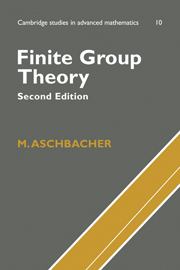Book contents
- Frontmatter
- Contents
- Preface
- 1 Preliminary results
- 2 Permutation representations
- 3 Representations of groups on groups
- 4 Linear representations
- 5 Permutation groups
- 6 Extensions of groups and modules
- 7 Spaces with forms
- 8 p-groups
- 9 Change of field of a linear representation
- 10 Presentations of groups
- 11 The generalized Fitting subgroup
- 12 Linear representations of finite groups
- 13 Transfer and fusion
- 14 The geometry of groups of Lie type
- 15 Signalizer functors
- 16 Finite simple groups
- Appendix
- References
- List of Symbols
- Index
6 - Extensions of groups and modules
Published online by Cambridge University Press: 05 June 2012
- Frontmatter
- Contents
- Preface
- 1 Preliminary results
- 2 Permutation representations
- 3 Representations of groups on groups
- 4 Linear representations
- 5 Permutation groups
- 6 Extensions of groups and modules
- 7 Spaces with forms
- 8 p-groups
- 9 Change of field of a linear representation
- 10 Presentations of groups
- 11 The generalized Fitting subgroup
- 12 Linear representations of finite groups
- 13 Transfer and fusion
- 14 The geometry of groups of Lie type
- 15 Signalizer functors
- 16 Finite simple groups
- Appendix
- References
- List of Symbols
- Index
Summary
Chapter 6 considers various questions about extensions of groups and modules, most particularly the conjugacy of complements to some fixed normal subgroup in a split group extension. Suppose G is represented on an abelian group or F-space V and form the semidirect product GV. Section 17 shows there is a bijection between the set of conjugacy classes of complements to V in GV and the 1-cohomology group H1(G, V). If V is an F-space so is H1(G, V). Moreover if CV(G) = 0 there is a largest member of the class of FG-modules U such that CU(G) = 0 and U is the extension of V by a module centralized by G. Indeed it turns out that if U is the largest member of this class then U/V ≅ H1(G, V). Further the dual of the statement is also true: that is if V = [V, G] then there is a largest FG-module U* such that U* = [U*, G] and U* is the extension of an FG-module Z by V with G centralizing Z. In this case Z ≅ H1(G, V*).
These results together with Maschke's Theorem are then used to prove the Schur–Zassenhaus Theorem, which gives reasonably complete information about extensions of a finite group B by a finite group A when the orders of A and B are relatively prime. The Schur–Zassenhaus Theorem is then used to prove Phillip Hall's extended Sylow Theorem for solvable groups.
- Type
- Chapter
- Information
- Finite Group Theory , pp. 64 - 74Publisher: Cambridge University PressPrint publication year: 2000

